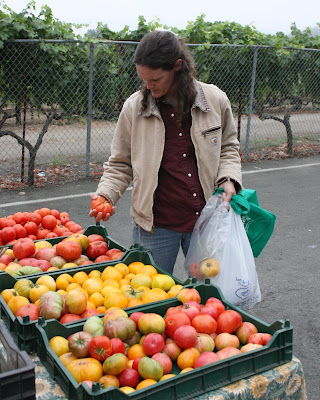 |
| Cap on and Cap Removed |
Ashley wrote this post last Sunday evening. -Matt
Bee day today! We worked with the hives today - including extracting honey! Hive #1 is the more aggressive of the two and some of the comb they make is a little funky and harder to work with. Hive #2 is calm and very orderly compared to the first. Both the hives are doing really well and were getting too full - of honey and brood. So, we took out five frames of honey from hive #1 and added a queen excluder and a honey super on top. We took seven frames full of capped honey from hive #2 and added another deep brood chamber under the queen excluder and honey super. So now both consist of two deep and one honey super.
Each time we do this we a learn a little more. This time I brought the honey frames up in two passes (while Matt was finishing getting the new frames and supers ready) because I always forget how heavy the honey is and getting it back up the hill to our honey shed is not an easy task. We also closed the door to the shed this time trying to stay mostly free of bees while we extracted the honey. The bees did, however, find the frames (in a covered bin) and eventually there were several hundred buzzing bees right in front of our house cleaning up all the honey we dripped. It is a little nerve racking having all those bees around but we both remained calm and I didn't get stung at all (which is odd for me) and Matt only got stung once.
We extracted close to three gallons of beautiful, amber honey. In order to extract the honey we take the full frame and with a hot knife we cut off the wax cap that the bees make to cover the honey. We then put the frame with cap removed into the honey extractor (just a simple centrifuge that holds three frames at a time) and spin the honey out of the cells. Then we flip the frame over and do the same to the other side. It goes through a strainer when it leaves the extractor and fills up the bucket. I have been amazed at how much honey these bees have produced this year. This batch should be mostly yellow star thistle and probably some blackberry and who knows what else mixed in. Right now there is still plenty of yellow star thistle around (as a vineyard manager I hate it but as a beekeeper I quite like it) so the bees should have plenty of pollen and nectar for a little while. Come fall, things get to be a little leaner because its usually pretty dry and there aren't very many flowers in bloom so we have to make sure the bees have enough honey in the hive to get them through a couple of tough months. This might be the last time we extract honey until early next year but who knows - these bees have been very busy indeed!
 |
| Honey Flow |
























